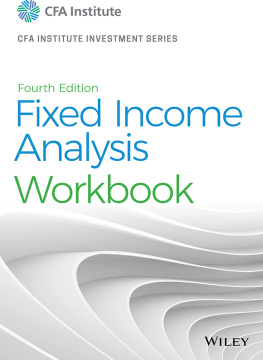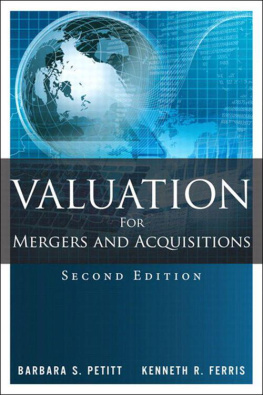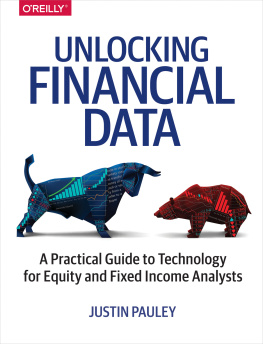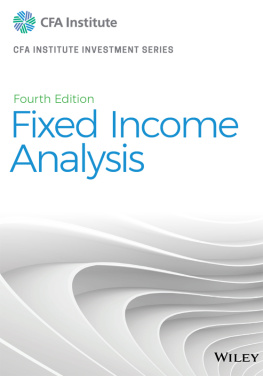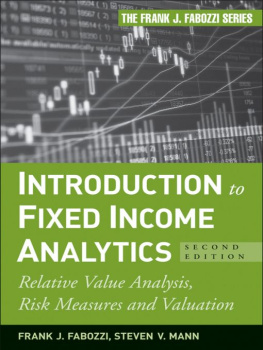
CFA Institute is the premier association for investment professionals around the world, with more than 150,000 CFA charterholders worldwide in 165+ countries and regions. Since 1963 the organization has developed and administered the renowned Chartered Financial Analyst Program. With a rich history of leading the investment profession, CFA Institute has set the highest standards in ethics, education, and professional excellence within the global investment community and is the foremost authority on investment profession conduct and practice. Each book in the CFA Institute Investment Series is geared toward industry practitioners along with graduate-level finance students and covers the most important topics in the industry. The authors of these cutting-edge books are themselves industry professionals and academics and bring their wealth of knowledge and expertise to this series.
FIXED INCOME
ANALYSIS
WORKBOOK
Fourth Edition
James F. Adams, PhD, CFA
Donald J. Smith, PhD
Cover image: Background maxkrasnov/iStock.com
Cover design: Wiley
Copyright 2020 by CFA Institute. All rights reserved.
Published by John Wiley & Sons, Inc., Hoboken, New Jersey.
The First, Second, and Third Editions of this book were published by Wiley in 2000, 2011, and 2015, respectively.
Published simultaneously in Canada.
No part of this publication may be reproduced, stored in a retrieval system, or transmitted in any form or by any means, electronic, mechanical, photocopying, recording, scanning, or otherwise, except as permitted under Section 1 07 or 108 of the 1976 United States Copyright Act, without either the prior written permission of the Publisher, or authorization through payment of the appropriate per-copy fee to the Copyright Clearance Center, Inc., 222 Rosewood Drive, Danvers, MA 01923, (978) 750-8400, fax (978) 646-8600, or on the Web at www.copyright.com. Requests to the Publisher for permission should be addressed to the Permissions Department, John Wiley & Sons, Inc., 111 River Street, Hoboken, NJ 07030, (201) 748-6011, fax (201) 748-6008, or online at www.wiley.com/go/permissions.
Limit of Liability/Disclaimer of Warranty: While the publisher and author have used their best efforts in preparing this book, they make no representations or warranties with respect to the accuracy or completeness of the contents of this book and specifically disclaim any implied warranties of merchantability or fitness for a particular purpose. No warranty may be created or extended by sales representatives or written sales materials. The advice and strategies contained herein may not be suitable for your situation. You should consult with a professional where appropriate. Neither the publisher nor author shall be liable for any loss of profit or any other commercial damages, including but not limited to special, incidental, consequential, or other damages.
For general information on our other products and services or for technical support, please contact our Customer Care Department within the United States at (800) 762-2974, outside the United States at (317) 572-3993, or fax ( 317) 572-4002.
Wiley publishes in a variety of print and electronic formats and by print-on-demand. Some material included with standard print versions of this book may not be included in e-books or in print-on-demand. If this book refers to media such as a CD or DVD that is not included in the version you purchased, you may download this material at http://booksupport.wiley.com. For more information about Wiley products, visit www.wiley.com.
ISBN 978-1-119-62744-9 (Paper)
ISBN 978-1-119-64687-7 (ePDF)
ISBN 978-1-119-62818-7 (ePub)
PART I
LEARNING OBJECTIVES,
SUMMARY OVERVIEW,
AND PROBLEMS
CHAPTER 1
Fixed-income Securities: Defining Elements
Learning Outcomes
After completing this chapter, you will be able to do the following:
- describe basic features of a fixed-income security;
- describe content of a bond indenture;
- compare affirmative and negative covenants and identify examples of each;
- describe how legal, regulatory, and tax considerations affect the issuance and trading of fixed-income securities;
- describe how cash flows of fixed-income securities are structured;
- describe contingency provisions affecting the timing and/or nature of cash flows of fixed-income securities and identify whether such provisions benefit the borrower or the lender.
Summary Overview
This chapter provides an introduction to the salient features of fixed-income securities while noting how these features vary among different types of securities. Important points include the following:
- The three important elements that an investor needs to know when investing in a fixed-income security are: (1) the bonds features, which determine its scheduled cash flows and thus the bondholders expected and actual return; (2) the legal, regulatory, and tax considerations that apply to the contractual agreement between the issuer and the bondholders; and (3) the contingency provisions that may affect the bonds scheduled cash flows.
- The basic features of a bond include the issuer, maturity, par value (or principal), coupon rate and frequency, and currency denomination.
- Issuers of bonds include supranational organizations, sovereign governments, non-sovereign governments, quasi-government entities, and corporate issuers.
- Bondholders are exposed to credit risk and may use bond credit ratings to assess the credit quality of a bond.
- A bonds principal is the amount the issuer agrees to pay the bondholder when the bond matures.
- The coupon rate is the interest rate that the issuer agrees to pay to the bondholder each year. The coupon rate can be a fixed rate or a floating rate. Bonds may offer annual, semi-annual, quarterly, or monthly coupon payments depending on the type of bond and where the bond is issued.
- Bonds can be issued in any currency. Bonds such as dual-currency bonds and currency option bonds are connected to two currencies.
- The yield to maturity is the discount rate that equates the present value of the bonds future cash flows until maturity to its price. Yield to maturity can be considered an estimate of the markets expectation for the bonds return.
- A plain vanilla bond has a known cash flow pattern. It has a fixed maturity date and pays a fixed rate of interest over the bonds life.
- The bond indenture or trust deed is the legal contract that describes the form of the bond, the issuers obligations, and the investors rights. The indenture is usually held by a financial institution called a trustee, which performs various duties specified in the indenture.
- The issuer is identified in the indenture by its legal name and is obligated to make timely payments of interest and repayment of principal.
- For asset-backed securities, the legal obligation to repay bondholders often lies with a separate legal entitythat is, a bankruptcy-remote vehicle that uses the assets as guarantees to back a bond issue.
- How the issuer intends to service the debt and repay the principal should be described in the indenture. The source of repayment proceeds varies depending on the type of bond.
- Collateral backing is a way to alleviate credit risk. Secured bonds are backed by assets or financial guarantees pledged to ensure debt payment. Examples of collateral-backed bonds include collateral trust bonds, equipment trust certificates, mortgage-backed securities, and covered bonds.
Next page
